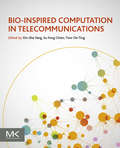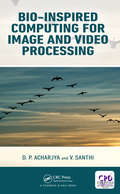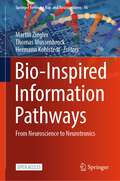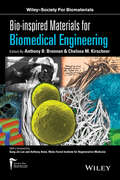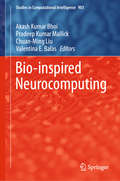- Table View
- List View
Bio-Inspired Algorithms in PID Controller Optimization (Intelligent Signal Processing and Data Analysis)
by Jagatheesan Kallannan Anand Baskaran Nilanjan Dey Amira S. AshourThis book discusses in-depth role of optimization to optimize the controller parameters with reference to bio-inspired algorithms. Comparative studies to evaluate the performance of different optimization techniques in terms of the settling time, overshoot and undershoot responses of the frequency deviations, tie-line power flow deviations, and the area control error are included, supported by examples. The book also includes different scenarios of the load frequency controller for single area as well as multi-area thermal power generating unit considering different algorithms. Key Features: Highlights the importance of tuning the power system controller parameters with emphasis on bio-inspiration algorithms Provides some applied applications/examples of the thermal power system Focusses on power system applications based on the optimization algorithms with different single area and multi-area thermal power systems Reports different cases on the interconnected power systems with providing optimal performance by optimizing the controller’s parameters
Bio-Inspired and Nanoscale Integrated Computing (Nature-Inspired Computing Series #1)
by Mary Eshaghian-WilnerBrings the latest advances in nanotechnology and biology to computing This pioneering book demonstrates how nanotechnology can create even faster, denser computing architectures and algorithms. Furthermore, it draws from the latest advances in biology with a focus on bio-inspired computing at the nanoscale, bringing to light several new and innovative applications such as nanoscale implantable biomedical devices and neural networks. Bio-Inspired and Nanoscale Integrated Computing features an expert team of interdisciplinary authors who offer readers the benefit of their own breakthroughs in integrated computing as well as a thorough investigation and analyses of the literature. Carefully edited, the book begins with an introductory chapter providing a general overview of the field. It ends with a chapter setting forth the common themes that tie the chapters together as well as a forecast of emerging avenues of research. Among the important topics addressed in the book are modeling of nano devices, quantum computing, quantum dot cellular automata, dielectrophoretic reconfigurable nano architectures, multilevel and three-dimensional nanomagnetic recording, spin-wave architectures and algorithms, fault-tolerant nanocomputing, molecular computing, self-assembly of supramolecular nanostructures, DNA nanotechnology and computing, nanoscale DNA sequence matching, medical nanorobotics, heterogeneous nanostructures for biomedical diagnostics, biomimetic cortical nanocircuits, bio-applications of carbon nanotubes, and nanoscale image processing. Readers in electrical engineering, computer science, and computational biology will gain new insights into how bio-inspired and nanoscale devices can be used to design the next generation of enhanced integrated circuits.
Bio-inspired Asymmetric Design and Building of Biomimetic Smart Single Nanochannels (Springer Theses)
by Xu HouIn this thesis, the author introduces various bio-inspired smart nanochannel systems. A strategy for design and preparation of novel artificial responsive symmetric/asymmetric single nanochannel systems under various symmetric/asymmetric stimuli is presented for the first time. The author’s research work utilizes ion track etching polymer nanochannels with different shapes as examples to demonstrate the feasibility of the design strategy for building novel artificial functional nanochannels using various symmetric/asymmetric physicochemical modifications. The development of these nanochannels and their potential applications is a burgeoning new area of research, and a number of exciting breakthroughs may be anticipated in the near future from the concepts and results reported in this thesis. Research into artificial functional nanochannels continues to drive new developments of various real-world applications, such as biosensors, energy conversion systems and nanofluidic devices. The work in this thesis has led to more than 15 publications in high-profile journals.
Bio-Inspired Collaborative Intelligent Control and Optimization (Studies in Systems, Decision and Control #118)
by Yongsheng Ding Lei Chen Kuangrong HaoThis book presents state-of-the-art research advances in the field of biologically inspired cooperative control theories and their applications. It describes various biologically inspired cooperative control and optimization approaches and highlights real-world examples in complex industrial processes. Multidisciplinary in nature and closely integrating theory and practice, the book will be of interest to all university researchers, control engineers and graduate students in intelligent systems and control who wish to learn the core principles, methods, algorithms, and applications.
Bio-Inspired Computation in Telecommunications
by Xin-She Yang Su Fong Chien T.O. TingBio-inspired computation, especially those based on swarm intelligence, has become increasingly popular in the last decade. Bio-Inspired Computation in Telecommunications reviews the latest developments in bio-inspired computation from both theory and application as they relate to telecommunications and image processing, providing a complete resource that analyzes and discusses the latest and future trends in research directions. Written by recognized experts, this is a must-have guide for researchers, telecommunication engineers, computer scientists and PhD students.
Bio-inspired Computation in Unmanned Aerial Vehicles
by Haibin Duan Pei LiBio-inspired Computation in Unmanned Aerial Vehicles focuses on the aspects of path planning, formation control, heterogeneous cooperative control and vision-based surveillance and navigation in Unmanned Aerial Vehicles (UAVs) from the perspective of bio-inspired computation. It helps readers to gain a comprehensive understanding of control-related problems in UAVs, presenting the latest advances in bio-inspired computation.By combining bio-inspired computation and UAV control problems, key questions are explored in depth, and each piece is content-rich while remaining accessible. With abundant illustrations of simulation work, this book links theory, algorithms and implementation procedures, demonstrating the simulation results with graphics that are intuitive without sacrificing academic rigor. Further, it pays due attention to both the conceptual framework and the implementation procedures.The book offers a valuable resource for scientists, researchers and graduate students in the field of Control, Aerospace Technology and Astronautics, especially those interested in artificial intelligence and Unmanned Aerial Vehicles.Professor Haibin Duan and Dr. Pei Li, both work at Beihang University (formerly Beijing University of Aeronautics & Astronautics, BUAA). Prof Duan's academic website is: http://hbduan.buaa.edu.cn
Bio-Inspired Computing and Networking
by Yang XiaoSeeking new methods to satisfy increasing communication demands, researchers continue to find inspiration from the complex systems found in nature. From ant-inspired allocation to a swarm algorithm derived from honeybees, Bio-Inspired Computing and Networking explains how the study of biological systems can significantly improve computing, networki
Bio-Inspired Computing for Image and Video Processing
by D. P. Acharjya V. SanthiIn recent years bio-inspired computational theories and tools have developed to assist people in extracting knowledge from high dimensional data. These differ in how they take a more evolutionary approach to learning, as opposed to traditional artificial intelligence (AI) and what could be described as 'creationist' methods. Instead bio-inspired computing takes a bottom-up, de-centralized approach that often involves the method of specifying a set of simple rules, a set of simple organisms which adhere to those rules, and of iteratively applying those rules. Bio-Inspired Computing for Image and Video Processing covers interesting and challenging new theories in image and video processing. It addresses the growing demand for image and video processing in diverse application areas, such as secured biomedical imaging, biometrics, remote sensing, texture understanding, pattern recognition, content-based image retrieval, and more. This book is perfect for students following this topic at both undergraduate and postgraduate level. It will also prove indispensable to researchers who have an interest in image processing using bio-inspired computing.
Bio-Inspired Computing for Image and Video Processing
by D. P. Acharjya V. SanthiIn recent years bio-inspired computational theories and tools have developed to assist people in extracting knowledge from high dimensional data. These differ in how they take a more evolutionary approach to learning, as opposed to traditional artificial intelligence (AI) and what could be described as 'creationist' methods. Instead bio-inspired computing takes a bottom-up, de-centralized approach that often involves the method of specifying a set of simple rules, a set of simple organisms which adhere to those rules, and of iteratively applying those rules. Bio-Inspired Computing for Image and Video Processing covers interesting and challenging new theories in image and video processing. It addresses the growing demand for image and video processing in diverse application areas, such as secured biomedical imaging, biometrics, remote sensing, texture understanding, pattern recognition, content-based image retrieval, and more. This book is perfect for students following this topic at both undergraduate and postgraduate level. It will also prove indispensable to researchers who have an interest in image processing using bio-inspired computing.
Bio-Inspired Hybrid Intelligent Systems for Image Analysis and Pattern Recognition (Studies in Computational Intelligence #256)
by Patricia Melin Witold PedryczBio-Inspired Hybrid Intelligent Systems for Image Analysis and Pattern Recognition comprises papers on diverse aspects of bio-inspired models, soft computing and hybrid intelligent systems. The articles are divided into four main parts. The first one consists of papers that propose new fuzzy and bio-inspired models to solve general problems. The second part deals with the main theme of modular neural networks in pattern recognition, which are basically papers using bio-inspired techniques. The third part contains papers that apply hybrid intelligent systems to the problem of time series analysis and prediction, while the fourth one shows papers dealing with bio-inspired models in optimization and robotics applications. An edited book in which both theoretical and application aspects are covered.
Bio-Inspired Information Pathways: From Neuroscience to Neurotronics (Springer Series on Bio- and Neurosystems #16)
by Martin Ziegler Thomas Mussenbrock Hermann KohlstedtThis open access book offers a timely and comprehensive review of the field of neurotronics. Gathering cutting-edge contributions from neuroscientists, biologists, psychologists, as well as physicists, microelectronics engineers and information scientists, it gives extensive information on fundamental information pathways in selected nervous systems. It also highlights their relevance as building blocks for novel computing architectures, such as bio-inspired electronic devices, neuromorphic architectures, memristive devices, adaptive sensors and emergent, pulsed-coupled oscillatory networks. All in all, this book offers a unique bridge between fundamental research in neuroscience, neural information processing, nonlinear dynamics, and self-organization, and advanced practical applications concerning the fabrication of hardware-oriented computing.
Bio-Inspired Land Remediation (Environmental Contamination Remediation and Management)
by Vimal Chandra PandeyLand is fundamental to the human life. The upper layer of land is a non-renewable resource, and source of food. Therefore, land health is essential to long-term food security and to promote sustainable livelihoods. On account of urbanization, industrialization and population growth, land pollution is one of the major issues worldwide. As a result, land pollution is continuing across the world, and has been linked with a wide range of potentially toxic contaminants at rates that deteriorate land quality. Land pollution can result either anthropogenic activities or natural activities. The major contaminants of land pollution are metalloids, petroleum hydrocarbon, radioactive elements, polyaromatic hydrocarbons (PAHs), Pesticide, other organic pollutants, etc. that comes from different types of sources. In urban and peri-urban areas, irrigation of agricultural land with polluted water is also a reason of land pollution. Therefore, land security is an important issue for future sustainability. Its remediation and management are important issue worldwide to protect land quality and functions. Land pollution means degradation of earth's surface. Polluted land comes under the category of degraded land. Hence, the remediation of polluted land is essential for regaining biodiversity and ecosystems services and thereby achieving United Nations-Sustainable Development Goals (UN-SDGs).This fact showed the need to develop research into land remediation. Bio-inspired land remediation has undergone a huge development. Therefore, Biomanagement has a lot of potential to secure upper earth’s surface through the land remediation programs targeted during the United Nations Decade on Ecosystem Restoration (2021-2030). This book explores the remediation of land pollution that includes Phytoremediation, Bioremediation (bacterial remediation and fungal remediation), Vermiremediation, Biochar-based remediation and other Bio-inspired remediation. This book will be a remarkable asset for research scholars, environmentalists, ecological scientist, agriculturist, practitioners, policy makers, entrepreneurs, and other stakeholders alike.
Bio-inspired Materials for Biomedical Engineering (Wiley-Society for Biomaterials)
by Anthony B. Brennan Chelsea M. KirschnerThis book covers the latest bio-inspired materials synthesis techniques and biomedical applications that are advancing the field of tissue engineering. Bio-inspired concepts for biomedical engineering are at the forefront of tissue engineering and regenerative medicine. Scientists, engineers and physicians are working together to replicate the sophisticated hierarchical organization and adaptability found in nature and selected by evolution to recapitulate the cellular microenvironment. This book demonstrates the dramatic clinical breakthroughs that have been made in engineering all four of the major tissue types and modulating the immune system. Part I (Engineering Bio-inspired Material Microenvironments) covers Bio-inspired Presentation of Chemical Cues, Bio-inspired Presentation of Physical Cues, and Bio-inspired Integration of Natural Materials. Part II (Bio-inspired Tissue Engineering) addresses tissue engineering in epithelial tissue, muscle tissue, connective tissue, and the immune system.
Bio-inspired Materials for Biomedical Engineering (Wiley-Society for Biomaterials)
by Anthony B. Brennan Chelsea M. KirschnerThis book covers the latest bio-inspired materials synthesis techniques and biomedical applications that are advancing the field of tissue engineering. Bio-inspired concepts for biomedical engineering are at the forefront of tissue engineering and regenerative medicine. Scientists, engineers and physicians are working together to replicate the sophisticated hierarchical organization and adaptability found in nature and selected by evolution to recapitulate the cellular microenvironment. This book demonstrates the dramatic clinical breakthroughs that have been made in engineering all four of the major tissue types and modulating the immune system. Part I (Engineering Bio-inspired Material Microenvironments) covers Bio-inspired Presentation of Chemical Cues, Bio-inspired Presentation of Physical Cues, and Bio-inspired Integration of Natural Materials. Part II (Bio-inspired Tissue Engineering) addresses tissue engineering in epithelial tissue, muscle tissue, connective tissue, and the immune system.
Bio-inspired Motor Control Strategies for Redundant and Flexible Manipulator with Application to Tooling Tasks (SpringerBriefs in Applied Sciences and Technology)
by Gia Hoang Phan Vijender Kumar Solanki Nguyen Ho QuangThis book presents a multi-disciplinary view of all aspects of rehabilitation robotics and non-invasive surgery, ideal for anyone new to the field. It includes perspectives from both engineers and clinicians. For skilled researchers and clinicians, it also summarizes current robot technologies and their application to various pathologies. The book will help the readers to develop the know-how and expertise necessary to guide those seeking a comprehensive understanding of this topic through their use of several commercial devices for robotic rehabilitation. The book targets the implementation of efficient robot strategies to facilitate the re-acquisition of motor skills. This technology incorporates the outcomes of behavioral studies on motor learning and its neural correlates into the design, implementation, and validation of robot agents that behave as optimal trainers, efficiently exploiting the structure and plasticity of the human sensorimotor systems.
Bio-Inspired Nanotechnology: From Surface Analysis to Applications
by Marc R. Knecht Tiffany R. WalshThis book focuses on the use of bio-inspired and biomimetic methods for the fabrication and activation of nanomaterials. This includes studies concerning the binding of the biomolecules to the surface of inorganic structures, structure/function relationships of the final materials and extensive discussions on the final applications of such biomimetic materials in unique applications including energy harvesting/storage, biomedical diagnostics and materials assembly.
Bio-inspired Neurocomputing (Studies in Computational Intelligence #903)
by Akash Kumar Bhoi Pradeep Kumar Mallick Chuan-Ming Liu Valentina E. BalasThis book covers the latest technological advances in neuro-computational intelligence in biological processes where the primary focus is on biologically inspired neuro-computational techniques. The theoretical and practical aspects of biomedical neural computing, brain-inspired computing, bio-computational models, artificial intelligence (AI) and machine learning (ML) approaches in biomedical data analytics are covered along with their qualitative and quantitative features. The contents cover numerous computational applications, methodologies and emerging challenges in the field of bio-soft computing and bio-signal processing. The authors have taken meticulous care in describing the fundamental concepts, identifying the research gap and highlighting the problems with the strategical computational approaches to address the ongoing challenges in bio-inspired models and algorithms. Given the range of topics covered, this book can be a valuable resource for students, researchers as well as practitioners interested in the rapidly evolving field of neurocomputing and biomedical data analytics.
Bio-Inspired Regenerative Medicine: Materials, Processes, and Clinical Applications
by Anna Tampieri Simone SprioThis book presents a wide and interdisciplinary overview of the current state of the art in the development of biomimetic materials for tissue regeneration on the basis of relevant and high-impact clinical needs. It specifically emphasizes the regeneration of bone, cartilage, and osteochondral tissues as well as soft tissues such as nerves, heart,
Bio-inspired Routing Protocols for Vehicular Ad-Hoc Networks: Bio-inspired Routing Protocols For Vehicular Ad-hoc Networks
by Salim Bitam Abdelhamid MelloukVehicular Ad-Hoc Networks (VANETs) play a key role to develop Intelligent Transportation Systems (ITS) aiming to achieve road safety and to guaranty needs of drivers and passengers, in addition to improve the transportation productivity. One of the most important challenges of this kind of networks is the data routing between VANET nodes which should be routed with high level of Quality of Service (QoS) to ensure receiving messages in the time. Then, the driver can take the appropriate decision to improve the road safety. In the literature, there are several routing protocols for VANETs which are more or less reliable to reach safety requirements. In this book, we start by describing all VANET basic concepts such as VANET definition, VANET versus Mobile ad-Hoc Network (MANET), architectures, routing definition and steps, Quality of Service (QoS) for VANET Routing, Metrics of evaluation, Experimentation, and simulation of VANETs, mobility patterns of VANET etc. Moreover, different routing protocols for routing in VANETs will be described. We propose two main categories to be presented: classical routing and bio-inspired routing. Concerning classical VANET, main principles and all phases will be overviewed, as well as, their two sub-categories which are topological and geographical protocols. After that, we propose a new category called bio-inspired routing which is inspired by natural phenomenon such as Ant colony, Bee life, Genetic operators etc. We present also, some referential protocols as example of each category. In this book, we focus on the idea of how to apply bio-inspired principle into VANET routing to improve road safety, and to ensure QoS of vehicular applications.
Bio-inspired Routing Protocols for Vehicular Ad-Hoc Networks
by Salim Bitam Abdelhamid MelloukVehicular Ad-Hoc Networks (VANETs) play a key role to develop Intelligent Transportation Systems (ITS) aiming to achieve road safety and to guaranty needs of drivers and passengers, in addition to improve the transportation productivity. One of the most important challenges of this kind of networks is the data routing between VANET nodes which should be routed with high level of Quality of Service (QoS) to ensure receiving messages in the time. Then, the driver can take the appropriate decision to improve the road safety. In the literature, there are several routing protocols for VANETs which are more or less reliable to reach safety requirements. In this book, we start by describing all VANET basic concepts such as VANET definition, VANET versus Mobile ad-Hoc Network (MANET), architectures, routing definition and steps, Quality of Service (QoS) for VANET Routing, Metrics of evaluation, Experimentation, and simulation of VANETs, mobility patterns of VANET etc. Moreover, different routing protocols for routing in VANETs will be described. We propose two main categories to be presented: classical routing and bio-inspired routing. Concerning classical VANET, main principles and all phases will be overviewed, as well as, their two sub-categories which are topological and geographical protocols. After that, we propose a new category called bio-inspired routing which is inspired by natural phenomenon such as Ant colony, Bee life, Genetic operators etc. We present also, some referential protocols as example of each category. In this book, we focus on the idea of how to apply bio-inspired principle into VANET routing to improve road safety, and to ensure QoS of vehicular applications.
Bio-Inspired Self-Organizing Robotic Systems (Studies in Computational Intelligence #355)
by Yan Meng Yaochu JinSelf-organizing approaches inspired from biological systems, such as social insects, genetic, molecular and cellular systems under morphogenesis, and human mental development, has enjoyed great success in advanced robotic systems that need to work in dynamic and changing environments. Compared with classical control methods for robotic systems, the major advantages of bio-inspired self-organizing robotic systems include robustness, self-repair and self-healing in the presence of system failures and/or malfunctions, high adaptability to environmental changes, and autonomous self-organization and self-reconfiguration without a centralized control. “Bio-inspired Self-organizing Robotic Systems” provides a valuable reference for scientists, practitioners and research students working on developing control algorithms for self-organizing engineered collective systems, such as swarm robotic systems, self-reconfigurable modular robots, smart material based robotic devices, unmanned aerial vehicles, and satellite constellations.
Bio-Inspired Silicon-Based Materials (Advances in Silicon Science #5)
by Paul M. ZeliskoThe contributed volume addresses a wide range of topics including, but not limited to, biotechnology, synthetic chemistry, polymer chemistry and materials chemistry. The book will serve as a specialized review of the field of biologically inspired silicon-based structures. Researchers studying biologically inspired silicon materials chemistry will find this volume invaluable.
Bio-inspired Structured Adhesives: Biological Prototypes, Fabrication, Tribological Properties, Contact Mechanics, and Novel Concepts (Biologically-Inspired Systems #9)
by Lars Heepe Longjian Xue Stanislav N. GorbThis book deals with the adhesion, friction and contact mechanics of living organisms. Further, it presents the remarkable adhesive abilities of the living organisms which inspired the design of novel micro- and nanostructured adhesives that can be used in various applications, such as climbing robots, reusable tapes, and biomedical bandages. The technologies for both the synthesis and construction of bio-inspired adhesive micro- and nanostructures, as well as their performance, are discussed in detail. Representatives of several animal groups, such as insects, spiders, tree frogs, and lizards, are able to walk on (and therefore attach to) tilted, vertical surfaces, and even ceilings in different environments. Studies have demonstrated that their highly specialized micro- and nanostructures, in combination with particular surface chemistries, are responsible for this impressive and reversible adhesion. These structures can maximize the formation of large effective contact areas on surfaces of varying roughness and chemical composition under different environmental conditions.
Bio-inspired Studies on Adhesion of a Thin Film on a Rigid Substrate (Springer Theses)
by Zhilong PengThe thesis systematically investigates the factors which influence many animals’ robust adhesion abilities and micro-reversible adhesion mechanisms, including the geometric principles of their adhesion, relative humidity, surface roughness and pre-tension. Studies exploring biological adhesion mechanisms are not only of great significance for the design of advanced adhesive materials and adhesion systems for micro-climbing robots, but also very helpful for resolving the problem of adhesion failure in MEMS/NEMS.
Bio-Inspired Technologies for the Hardware of Adaptive Systems: Real-World Implementations and Applications (Studies in Computational Intelligence #179)
by Mircea Gh. Negoita Sorin HinteaEvolvable Hardware (EHW) has emerged as a sub-domain of artificial evolution represented by a design methodology (consortium of methods) involving the application of Evolutionary Algorithms (EA) to the synthesis of digital and analogue electronic circuits and systems. Nevertheless, the most benefit for the society and indeed most revolutionizing application of EA is its hardware implementation leading to the EHW. These new EA based methodologies led to a new type of machines that is evolved to attain a desired behaviour, which means they have a behavioural computational intelligence. EHW is a special case of the adaptive hardware, namely being strongly related to the Adaptive Systems (AS) and the Adaptive Hardware (AH). The book presents a careful selection of the field that very well reflects the breadth of this high technology and its terminology and applications in context of the AS/AH. The harmonious symbiosis of the engineering approach and the accurate scientific methodology features the aspects of highly relevant and practical design principles governing the development of EHW and its connections with AS/AH. This book is both attractive and useful for everybody interested in the design and analysis of EHW in context of AS/AH and implementation of real time adaptive hardware hybrid intelligent systems.




